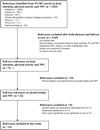Alcohol consumption and the risk of nasopharyngeal carcinoma: a systematic review
- PMID: 19116871
- PMCID: PMC3072894
- DOI: 10.1080/01635580802372633
Alcohol consumption and the risk of nasopharyngeal carcinoma: a systematic review
Abstract
The evidence concerning the influence of alcohol drinking on the risk of nasopharyngeal carcinoma (NPC) has yielded intriguing findings but has lacked a clear-cut interpretation due to inconsistencies. To unify this body of evidence, we performed a systematic review. With funding and using a protocol developed by the World Cancer Research Fund (WCRF), 15 bibliographic databases were searched for epidemiological studies that reported a measure of association between alcoholic beverage consumption and NPC. Pooled odds ratios (ORs) for highest-vs.-lowest categories of total alcohol intake was obtained by using an inverse-variance weighted random-effects model. A dose-response trend was examined in models using generalized least square estimation. The search identified 14 case-control studies from 5 countries. For total alcohol intake, the pooled ORs in a comparison of the highest to the lowest category was 1.33 (95% CI: = 1.09-1.62) in 11 studies. Data from 6 studies indicated a J-shape dose-response trend, with NPC risk decreasing with up to 15 drinks/wk and increasing with higher intake. Fewer data were available to assess the associations between NPC and intake of beer, wine, and spirits. The potential J-shaped dose-response trend suggests a reduced risk of NPC related to the light alcohol drinking, an observation that warrants further study. Considered in total, the quantitative summaries of the case-control evidence suggest that heavy alcohol consumption is associated with an increased risk of NPC.
Figures



References
-
- GLOBOCAN 2000: Cancer Incidence, Mortality and Prevalence Worldwide. Version 1.0. Lyon, France: IARC Press; 2001.
-
- Parkin DM, Bray F, Ferlay J, Pisani P. Estimating the world cancer burden: Globocan 2000. Int J Cancer. 2001;94:153–156. - PubMed
-
- Yu MC, Ho JH, Ross RK, Henderson BE. Nasopharyngeal carcinoma in Chinese—salted fish or inhaled smoke? Prev Med. 1981;10:15–24. - PubMed
-
- Yu MC, Ho JH, Lai SH, Henderson BE. Cantonese-style salted fish as a cause of nasopharyngeal carcinoma: report of a case-control study in Hong Kong. Cancer Res. 1986;46:956–961. - PubMed
-
- Yu MC, Mo CC, Chong WX, Yeh FS, Henderson BE. Preserved foods and nasopharyngeal carcinoma: a case-control study in Guangxi, China. Cancer Res. 1988;48:1954–1959. - PubMed
Publication types
MeSH terms
Grants and funding
LinkOut - more resources
Full Text Sources
Medical
